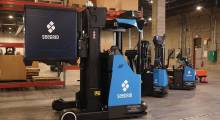Increasingly intelligent lift trucks and operations mean training is becoming less of a single event and more an ongoing refinement of skills and processes.
According to Tom Lego, national manager of training and the Customer Center for Toyota Materials Handling USA, sophisticated equipment and sophisticated operators require a consistent focus.
Beyond continuous improvement, it’s a critical element in the face of rapidly evolving working conditions.
“An organization using materials handling equipment has to make it a daily activity to assess anything changing in their facility,” Lego says.
“A lot of organizations continue to try to tweak, move things around and do things a little better. They need a heightened awareness to ensure equipment is specified for the situation and those specs are revisited as things change.”
The best way to avoid missing small details that can have big consequences is to appreciate that the environment will change as time goes on, he says.
Most will recognize the need for product-specific training if an operator uses a different type of equipment, but he says it goes beyond the operator to the supervisor, who must be aware of how equipment is being used and how the application, equipment and training might need to be changed.
For example, if there is only one forklift on the dock, a backup alarm makes sense. If operations change and now multiple forklifts are on the dock, the combination of several backup alarms will result in continuous, unhelpful noise.
“It might be that you need some other way to heighten awareness of movement in that area,” Lego says, “but no accessory can take the place of a well-trained operator with a good understanding of the environment.”
Pedestrians working around forklifts need a healthy respect for the equipment, appropriate training, and clearly marked walking areas. Floor markings prompt pedestrians at intersections to stop and point in their intended direction, providing a visual “turn signal” to communicate with equipment operators. In some cases it may make sense to modify the building to improve visibility.
Another important step is to instill the discipline that any near-miss should be investigated and treated as if the worst-case scenario had happened.
“Say a forklift operator loses a part around a corner. Don’t just pick it up and say, ‘good thing nothing happened.’ Treat it with the same diligence as if someone had been injured so you can change processes before they become actual accidents,” he says.
In addition to discipline, pride in equipment can be a safety tool, Lego says. He encourages operators to avoid so much as a scratch on their equipment.
“It might sound extreme, but a scratch means it contacted something it was not supposed to. The operator might say they didn’t intend to hit or squeeze through an area where there wasn’t quite enough room, but they wouldn’t use their own car to nudge a shopping cart out of the way in the Walmart parking lot.”
You may have many investigations and reports in the first month, Lego says, but after associates realize the seriousness of the message that work will fade away. “Instead of pushing pallets—or operational issues—out of the way,” he says, “talk about why conditions are not as they should be.”
Article topics








